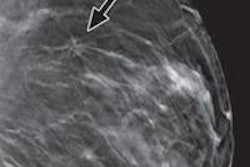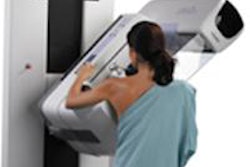
The combination of conventional mammography and breast tomosynthesis detects more invasive cancers than mammography alone -- potentially addressing the debate on overdiagnosis in mammography, according to a September 19 presentation at the American Roentgen Ray Society (ARRS) Breast Imaging Symposium (BIS) in Phoenix.
"Everyone is telling us that we're overdiagnosing disease that doesn't kill patients, namely DCIS, and missing disease that can," said Dr. Margarita Zuley of the University of Pittsburgh. "Tomosynthesis finds the cancers we really want to find."
 Dr. Margarita Zuley from the University of Pittsburgh.
Dr. Margarita Zuley from the University of Pittsburgh.
Zuley presented a literature overview to session attendees that highlighted the benefits of tomosynthesis. For example, she described a study by Dr. Brian Haas and colleagues from Yale University that compared screening recall rates and cancer detection rates for conventional digital mammography alone versus tomosynthesis plus mammography (Radiology, July 30, 2013). Adding tomosynthesis resulted in a 30% reduction in the overall recall rate, from 12% for mammography alone to 8.4% in the tomosynthesis group, Zuley said.
"That's significant, a recall rate reduction of 30%," she added.
Zuley also referred to a study conducted by Dr. Per Skaane, PhD, of the University of Oslo, and colleagues. They found that when tomosynthesis is used in combination with conventional digital mammography, it detects 40% more invasive cancers and decreases false-positive rates by 15% (Radiology, April 2013, Vol. 267:1, pp. 47-56). In addition, Zuley mentioned a study out of Massachusetts General Hospital which found that adding tomosynthesis to digital mammography boosted diagnostic accuracy (Rafferty et al, Radiology, January 2013, Vol. 266:1, pp. 104-113).
"In Dr. Skaane's study, tomosynthesis found 25 additional invasive cancers, and 10 of them were nuclear grade 2 or higher," Zuley said. "And these additional cancers were detected across all breast densities. These are the cancers we want to find; these are what we're after."
Zuley also cited a study by Dr. Daniel Kopans and colleagues from Massachusetts General Hospital that compared the clarity of calcifications on conventional mammography versus tomosynthesis. Clarity was defined as the sharpness, contrast, and diagnostic quality by which the calcifications were depicted.
Kopans and colleagues found that in 92% of the cases, the clarity of calcifications on tomosynthesis was equal to or better than clarity on conventional mammography. Furthermore, in almost half, the clarity on tomosynthesis was judged to be better than with 2D mammography (Breast Journal, November/December 2011, Vol. 17:6, pp. 638-644).
"If we're going to use it in diagnosis, it has to be as good as the standard work we do," Zuley said. "It has to be able to replace traditional views."




















